#002
“New Human” to Be
Generated by
Interactive Media
Yasuaki Kakehi
Japanese Color: USUAKE-iro
#002
Yasuaki Kakehi
Japanese Color: USUAKE-iro
MOVIE

Associate Professor
Faculty of Environment and Information Studies
The world of interactive media that designs new relationships between humans, objects and the environment.
What Associate Professor Yasuaki Kakehi creates is a world that expands human potential by removing the barrier between Atoms and Bits.
It is not a world where the advance in technology deprives humans of their unlimited potential.
Rather, it is a world harmonized with humans that extends the limits of what humans can do, and allows them to become a “New Human” oriented toward an even higher phase.
Inter-Action is, in a manner, the design of the relationship between action and action. It is the design of what is intended to mark a new relationship between humans and humans, between humans and objects, and between humans and their environment. Since the 1990s, the importance of such interactive design has been emphasized. When a new medium becomes prominent in society, how interaction with it – how humans relate with it – should develop is discussed. The term “interactive media, ” which I specialize in, connotes the resolve to build a new media from the ground up ourselves, and design the relationship between humans and their environment.
One of the keywords indicative of this approach is the idea of “Designing Real.” By building a bridge between the physical world (Atoms) where we find our own bodies, and the digital world (Bits) that is composed of computers, we are cultivating a new REAL – one that fuses the characteristic features of both worlds. In such a world, we believe, we can find a new form of media, one where the environment and humans are so deeply fused and integrated it is hard to distinguish between Atoms and Bits.

Looking at society from the perspective of interactive media, it is clear we are presently ushering in a major paradigm shift. Until now, there has been the framework in place where we extract information via an interface from the digital world that stretches out on the other side of the box-shaped “window” we call computers. In this framework, the world that holds our bodies and physical things, and the digital world do not directly influence each other. As soon as this window is removed, however, resources that exist on this side and resources that exist on the other side are connected and integrated. This may cause some sort of chemical reaction, creating an entirely new experience never seen before. Therefore, the barrier between the physical world and the digital world is finally about to be removed. From here, we believe, the new world with unprecedentedly huge resources will be born.
When I think of a world beyond the transformation of media, I certainly do not want to see a world where humans merely benefit from it and become passive. As we address the singularity now in realistic terms, I would like to see a future society where human potential expands further, not one where humans do not have to do anything or cannot do anything. To this end, we will not stop at just presenting new points of view and experiences, but we will also conceive of designs that lead to the next evolution of humans.
The TECHTILE toolkit makes interactive media easier to understand. This is a toolkit that records and edits “tactile sensation” and transmits it. Using simple equipment such as an oscillator, a microphone and an amplifier, it records, edits and transmits the tactile sensation of an object. For example, the real tactile sensation of a marble in a cup held by one person is transmitted to an empty cup held by another person without losing any of the sensation. Or, the sound of hitting a shuttlecock by a racket is recorded by a personal computer as digital data, and when it is converted into oscillation data, it gives one real tactile sensation by oscillating an oscillator.
Like a magician, so to speak, we provided equipment that not only presents something never seen before, but also allows any user to make things he or she really needs or really wants to make. This was chosen among the Best 100 of the Good Design Awards in FY2012.
In dePENd, a ballpoint pen you can find anywhere moves spontaneously due to magnetism. It can draw graphics and designs preinstalled in a computer, but it goes far beyond that, and has the potential of generating new creativity by interaction between a pen and a human.
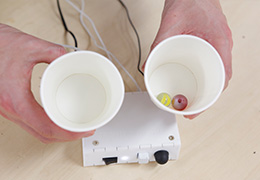
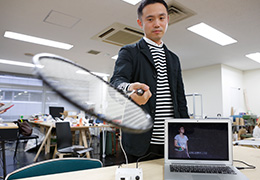
Previously, interaction with computers mainly was audiovisual. But the TECHTILE toolkit records, edits and transmits “tactile sensation.” This system is disclosed in the Open Source.
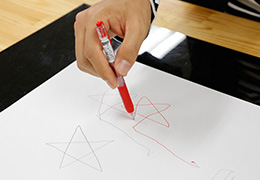
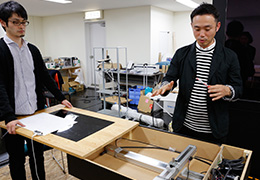
dePENd is a system for expanding and supporting sketches through the fusion of pens and paper. By attracting the head of a ballpoint pen by magnetism, it can draw designs and graphics preinstalled in a computer and supports the human body’s spontaneous movements.
For me, another keyword is “HABILITATE.” This verb was coined by dropping “Re” from the word “rehabilitate.” While rehabilitation refers to returning one’s state from ‘minus’ to ‘zero’ and adapting to the environment “gain (Re),” “HABILITATE” offers a more positive nuance of seeking an uplifting influence on one’s state from the starting point that is the present.
So far, interactive media has played the role of showing us the near future. On the other hand, we have to admit that this has led to the lack of a “sense of being on the site,” or a sense of how interactive media is going to change the way humans actually live. As technology is conclusive as technology, we believe that it is very important to be able to talk about what sorts of experiences or expressions we can find beyond that in the process.
The range of our activities expands each day. For example, the advance in nanotechnology makes it possible for technology to intervene into the human body itself. This presents a new issue in the sense that the boundary between technology and humans is becoming blurred, and also presents a new challenge in the sense that the fields we can work in are also broadening.
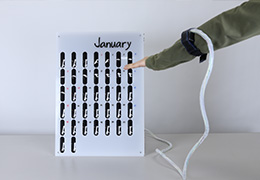
HABI tools, an example of implementation of the HABILITATE, are custom tools to support people who seek recovery through rehabilitation. They encourage users to do specific exercises necessary for rehabilitation and record bodily movements using sensors. This photo shows a piece that records and presents the achievements of training by moving arms.
We will develop new designs by harmonizing and incorporating physical materials and the investigation and development of phenomena – psychological and physiological knowledge and phenomena of human bodies – as well as the development trends of computers. In a sense, we are like magicians who give concrete forms to illusions, or practicing physicians who give them back to humans and society.
To do that requires a stance of bringing fresh surprises out of digital media, an ability to create new tools and spaces by combining hardware, software and physical materials, as well as the drive to promptly apply them not only to major issues in society but also to small problems in our everyday lives.
Going forward, our way of life, which constantly benefits from technology, will accelerate further. In the future phase, the definition of the human “body” and what humans can do will certainly be called into question. I believe that a “New Human” will be generated at this time. In other words, the line we draw between humans and technology is going to change.
My future vision is the generation of this “New Human”. In steps toward that, almost everything will become interactive, and we should be able to create a world far more dynamic than the one at present. I myself would like to see such a world.
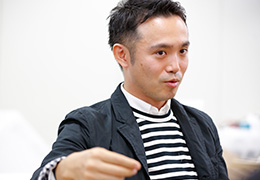

Yasuaki Kakehi
Completed the University of Tokyo Graduate School of Interdisciplinary Information Studies Doctoral Program in 2007. Doctor of Interdisciplinary Information Studies. Joined the Faculty of Environment and Information Studies, Keio University as a Full-time Undergraduate Lecturer in 2008 after working at the Japan Science and Technology Agency as a researcher in the PRESTO Program. Serves as an Associate Professor at the same institution since 2010. Major prizes include the 2012 Good Design Best100 Award and the Minister of Education, Culture, Sports, Science and Technology’s 2014 Young Scientist’s Award, among others.
(Japanese Only)http://www.xlab.sfc.keio.ac.jp/

2015.Mar.ISSUE